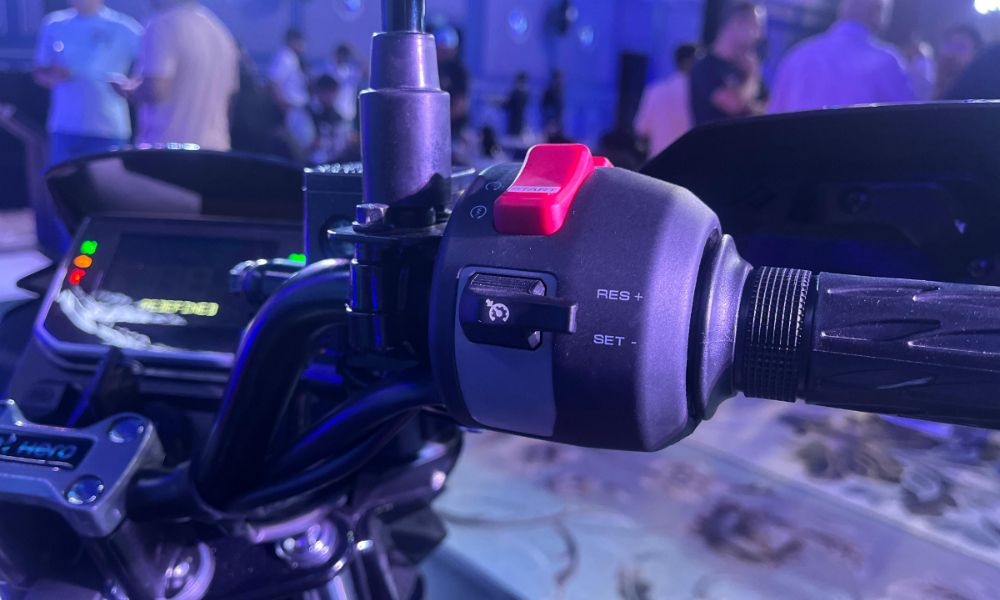Driving around in the city mode, thereâs plenty of power for quick overtakes and closing gaps to the vehicles ahead.
Driving the Tata Harrier.ev
Before we get to the driving part, letâs look at whatâs underneath the Harrier.ev. You can have the Tata Harrier.ev in a total of 3 configurations â a. 65 kWh RWD, b. 75 kWh RWD and c. 75 kWh QWD. We got to test drive the fully equipped 75 kWh QWD version of the Harrier.ev which has a kerb weight of 2,335 kg (RWD version has a kerb weight of 2,237 kg). These are LFP battery packs with cylindrical cells from Octillion Power Systems. They’re currently being manufactured in India and come with an unlimited km, lifetime warranty. Please note that the lifetime period is set at 15 years from the date of first vehicle registration. For the second registration, the warranty changes to 10 years from the date of first registration and 2 lakh km.
In the rear-wheel drive configuration (for both battery pack options â 65 kWh & 75 kWh), you have a single motor on the rear axle. This is a Permanent Magnet Synchronous Motor (PMSM) that makes 235 BHP & 315 Nm, which has been designed by Schaeffler. In the QWD or all-wheel drive setup, you have another motor on the front axle, which is the secondary motor. The motor on the front axle is an induction motor and not a PMSM. It makes 156 BHP and 164 Nm. The front induction motor is locally manufactured by Tata AutoComp in Pune with over 80% part localisation. A question that some of you might have is, why does the Harrier.ev have different kinds of motors on the front and rear axle? Why not keep it simple and provide the same kind of motor on both axles? The answer has to do with the application. The Harrier.ev is not a sports car, but an SUV. So, the front motor is basically there to assist the rear motor. In theory, the working principle of both PMSM and induction motors is similar. The PMSM has a higher power density, which means it can deliver more power and better efficiency. It is more expensive in comparison with and induction motors, which doesnât have rare-earth metals, and hence, is cheaper. An induction motor is also less complex and hence, more durable. In the Harrier.ev QWD, the induction motor helps you get out of some tricky situations.
Now that the technical part is done, letâs get to the driving part of the Harrier.ev 75kWh QWD. When you look at the power and torque numbers, some might think that itâs extremely eager to put that power down on the road. But thatâs not really the case. Given that thereâs so much power and torque on offer, the Harrier.ev gets off smoothly from a standstill. The acceleration isnât snappy, and as long as you are gentle, your passengers wonât complain. Despite a linear power delivery, you will be getting up to speed pretty quickly. Driving around in the city mode, thereâs plenty of power for quick overtakes and closing gaps to the vehicles ahead. I switched to Eco mode when driving in some heavy traffic, and the car felt even smoother. More importantly, thereâs enough power on tap even in Eco mode to keep up with the traffic and even overtake quickly. While the accelerator may feel dull, the car never feels sluggish.
We also got to spend some time cruising on the highway and the Harrier.ev felt quite comfortable at triple-digit speeds. On the Delhi-Mumbai expressway, at a speed of 120 km/h, the car was cruising effortlessly. Overtaking on the highways was taken care of without breaking a sweat. You could pass slower traffic even in Eco mode, but if you want to overtake a car quickly, itâs better to be in City mode or Sport mode. Tata claims that the Harrier.ev QWD can accelerate from 0-100 km/h in 6.3 seconds in Boost mode, which is very believable. Note that the Boost mode is available only on the QWD variant and provides an additional 40 BHP & 40 Nm, which means thereâs an actual boost. We tried a couple of acceleration runs, and the car puts down power nicely without much wheel spin.
On the QWD version, there are 4 driving modes to choose from. They’re mapped specifically for different driving styles. Whatâs appreciable is that the motor’s characteristics are distinct in each mode.
- City Mode: The default mode. The car always restarts in this mode, no matter what mode you last drove in. It’s great for driving in the city as well as on the highway. Strikes a good balance between power and economy.
- Eco Mode: The mode to engage when you want the maximum range. The throttle response is dulled down, which results in a smoother drive in the city (less of that “torque-pull” effect). Power comes in more gradually when you ask for it. If youâre a sedate driver, you will not want to move away from this mode as it takes care of all driving conditions. Even overtakes are done quite easily in Eco mode, and itâs only when you want to overtake very quickly that youâll want to get out of Eco, but thatâs very rare.
- Sport Mode: The mode to engage when you want to have fun. Floor the A-pedal in this mode and watch the traction control warning light flash in the instrument cluster. In this mode, the throttle response is sharper, and the car just feels more eager to get a move on. However, it can feel too peaky for city driving and also eats up the battery faster. Use “Sport” when you’re looking for fun on expressway runs.
- Boost Mode: Lastly, this mode is purely when you want that extra âBoostâ. True to its name, you get an additional 40 BHP & 40 Nm in this mode, which allows you to propel this car from 0-100 km/h in 6.3 seconds. We even used this mode while going up an incline of 34 degrees during the off-road session. You can instantly feel the torque, and wheel spin is well-controlled.
There are also 6 Terrain Modes – Normal, Snow/Grass, Mud-Ruts, Sand, Rock Crawl and Custom that alter the traction as needed when driving in different conditions.
Regenerative Braking
You get 4 levels of regenerative braking, which can be adjusted using the paddles placed behind the steering wheel. On level 0, there is no regeneration. In level 1, the regen is subtle and doesnât feel very forced. I found the regen to be too low for my liking in this mode while bblost preferred this or the level 0. I was using the level 2 most as it had the closest resemblance to engine braking. Level 3 has maximum regeneration, and people who drive in the city and want to extract maximum range will end up using it. Some people enjoy driving in maximum regeneration mode, while some prefer not having any regeneration. Thatâs why we love adjustable regen settings. Anyone can tune them to suit their liking. You can also do one-pedal driving in many situations. However, do keep in mind that the car will not come to a complete halt. It will keep crawling forward without any throttle input.
Noise, Vibration & Harshness (NVH)
The inherently silent nature of EVs amplifies the other aspects like wind noise and tyre noise. The cabin is well isolated from the outside noise when driving around in the city. You can also play some good music through the sound system to further isolate yourself. On the highway, the wind and tyre noise at 120 km/h is acceptable. You will hear the hum from the low rolling resistance tyres, but itâs never excessive.
Range
The Harrier.evâs ARAI tested MIDC (Part 1 + Part 2 Cycles) range for the three variants is –
- 65 Kwh Rwd Variant – 538 km
- 75 Kwh Rwd Variant – 627 km
- 75 kWh QWD rail – 622 km
Tata has also shared a number called the C75 range, which is what they claim 75% of the customers will get. The C75 range test that Tata has done factors in ambient temperature, load and A/C. A single cycle of the C75 test is done at an average speed of 40 km/h over a distance of 30 km, where the maximum speed reached is 120 km/h. Hereâs the C75 range for the three variants –
- 65 Kwh Rwd Variant – 420-445 km
- 75 Kwh Rwd Variant – 480-505 km
- 75 kWh QWD rail – 460-490 km
Weâll wait for some ownership reviews to get an idea of more real-world range figures, but as of now, itâs safe to assume that the number is in between 400 and 450 km.
Charging
The Harrier.ev allows for 1.5C peak charging at 120 kW (DC Fast Charging), which can charge the battery from 20% to 80% in 25 minutes. As mentioned earlier, you can opt for a 7.2 kW AC fast charger for an additional amount of Rs. 49,000. With this charger, you can charge the 75 kWh battery from 10% to 100% in 10.7 hours (9.3 hours for the 65 kWh battery pack).
Suspension

Ride Comfort
The Harrier.ev gets independent McPherson strut suspension at the front and multilink suspension with stabiliser bar at the rear. For reference, the Harrier diesel comes with a torsion beam rear suspension, and the addition of multi-link rear suspension has made a lot of difference to the dynamics of the car. Also, given that the Harrier.ev has a motor on the rear axle, the independent multilink rear suspension was mandatory. Tata has chosen dampers with frequency-selective damping (FSD) or frequency-dependent damping (FDD). And while these may not have the ability to change the damping as per the drive modes like you can in semi-active or active dampers, theyâre pretty good at adapting to road conditions.
Start driving, and you will notice that the suspension setup isnât super stiff like your typical EVs. This was quite a surprise as most of the EVs that are IC-engine converts usually have a stiff suspension setup. However, since Tata has changed the entire suspension assembly for the Harrier.ev, it has allowed the engineers a lot of bandwidth to tune the suspension. The ride quality is good in the city, and it feels very similar to the regular diesel Harrier. The suspension is absorbent and feels rugged. There is a firm edge to it and you feel potholes inside the cabin, but I donât think a lot of owners are going to complain about the ride quality. The top variants are equipped with 19-inch alloy wheels shod with 245/55-section tyres. Lower variants equipped with 18-inch wheels should have a slightly better ride.
As of now, people actively considering buying an EV in this segment are comparing the Harrier.ev with the Mahindra XEV 9e and rightly so. When it comes to the suspension tuning, thereâs one advantage that the Mahindra has, which is semi-active dampers that can adjust the damping based on the drive modes. Comparing the comfort levels of both these cars, theyâre pretty close, but I feel the Harrier.ev has a slight edge over the XEV 9e in this department.
Handling & Dynamics
The straight-line stability of the Harrier.ev is good. The car feels very planted at 120 km/h on normal roads. There’s no unnecessary vertical movement when going over expansion joints, and the car doesnât feel nervous at any point. From straight roads to some high-speed bends and the Harrier.ev manages to hold its line well. We took some long bends at high speeds in an empty parking space, and the car performed well. The tyres have low rolling resistance and arenât meant for performance. Hence, they start chirping when you push hard. Try taking some corners hard, and you will feel the bulk of the vehicle. It’s obviously way better than the diesel Harrier which has a twist beam rear suspension. The multilink suspension in the EV makes a huge difference.
One of the biggest gripes weâve had since the launch of the Harrier is the placement of the ORVMs. Itâs too high, and thereâs a big blind spot because of which you cannot see corners properly. Overall, the chassis doesnât feel very tight and something youâd enjoy pushing hard in corners. Comparatively, the Mahindra felt better in this aspect.
Steering
The EPS is a nice unit to use and is pretty light at city speeds. The Harrier.ev is fairly easy to manoeuvre in the city and masks the bulk of the car. It weighs up nicely when you build up speed on the highway. The steering weighs up in Sport mode as well, but enthusiasts will want some additional weight from the front end. Itâs fairly direct, but doesnât give you a lot of confidence to attack corners.
Braking
You get all-wheel disc brakes as standard in the Harrier.ev. The performance is predictable, and the car sheds speed effectively. There is a spongy feel to the pedal, but once you get used to the feel, modulation is easy. Emergency braking is also handled very well, and the car comes to a halt in a predictable manner.
Continue reading the discussion on the Tata Harrier.ev on our forum.
Â







